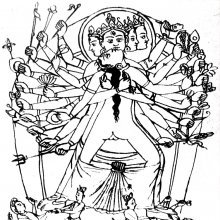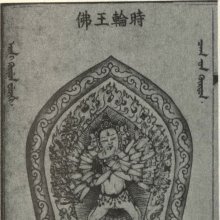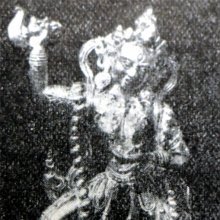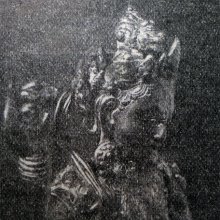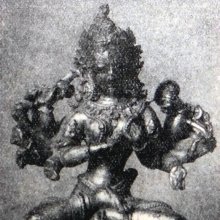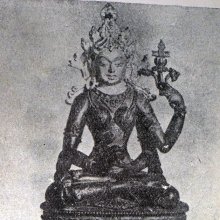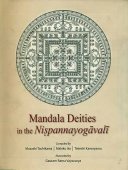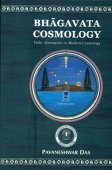Kalacakra, Kālacakra, Kala-cakra: 27 definitions
Introduction:
Kalacakra means something in Buddhism, Pali, Hinduism, Sanskrit, Jainism, Prakrit, the history of ancient India, Marathi, Hindi. If you want to know the exact meaning, history, etymology or English translation of this term then check out the descriptions on this page. Add your comment or reference to a book if you want to contribute to this summary article.
Alternative spellings of this word include Kalachakra.
Images (photo gallery)
(+2 more images available)
In Hinduism
Purana and Itihasa (epic history)
Source: archive.org: Shiva Purana - English TranslationKālacakra (कालचक्र) refers to the “wheel of time” situated beyond the fifty-six worlds ending with Ahiṃsāloka, as defined in the Śivapurāṇa 1.17. Accordingly, “[...] the action-lord (Kāryeśvara) who has screened everything is stationed in the city of Jñānakailāsa in the Ahiṃsā region (ahiṃsāloka). At the end of the same is the wheel of Time (Kālacakra) and beyond the ken of Time there is the space called Kālātīta. There Kāla (God of death and Time) backed by Śiva and in the name of Cakreśvara, unites every one with Time”.
The Kālacakra consists of five wheels, one being over the other:—
- Sight and delusion (drṣṭi and moha) constitute the Brahmacakra;
- Enjoyment and delusion (bhoga and moha) constitute the Viṣṇucakra.
- Anger and delusion (kopa and moha) constitute the Raudracakra,
- Revolution (bhramaṇa) is Īśvaracakra.
- Knowledge and illusion (jñāna and moha) constitute the Śivacakra.
“Thus scholars have explained the five cakras”.
Source: Cologne Digital Sanskrit Dictionaries: The Purana Index1a) Kālacakra (कालचक्र).—A chief Vānara.*
- * Brahmāṇḍa-purāṇa III. 7. 235.
1b) Is the solar system: relativity of its movement is illustrated by the Potter's wheel. The sun stands in relation to kālacakra, midway between the Earth and Heaven. Placed on the right side of Meru, the twentyeight nakṣatras including abhijit are fixed on this cakra.1 The seat of mahākāla.2
- 1) Bhāgavata-purāṇa V. 22. 2-11; 23. 3; Matsya-purāṇa 162, 1, 19; Viṣṇu-purāṇa II. 8. 4.
- 2) Brahmāṇḍa-purāṇa IV. 32. 7. 18-20.

The Purana (पुराण, purāṇas) refers to Sanskrit literature preserving ancient India’s vast cultural history, including historical legends, religious ceremonies, various arts and sciences. The eighteen mahapuranas total over 400,000 shlokas (metrical couplets) and date to at least several centuries BCE.
Dhanurveda (science of warfare)
Source: Wisdom Library: DhanurvedaKālacakra (कालचक्र) refers to a weapon (“wheel of time”, “cycle”). It is a Sanskrit word defined in the Dhanurveda-saṃhitā, which contains a list of no less than 117 weapons. The Dhanurveda-saṃhitā is said to have been composed by the sage Vasiṣṭha, who in turn transmitted it trough a tradition of sages, which can eventually be traced to Śiva and Brahmā.
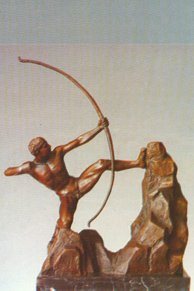
Dhanurveda (धनुर्वेद) refers to the “knowledge of warfare” and, as an upaveda, is associated with the Ṛgveda. It contains instructions on warfare, archery and ancient Indian martial arts, dating back to the 2nd-3rd millennium BCE.
Kavya (poetry)
Source: Wisdom Library: KathāsaritsāgaraKālacakra (कालचक्र) was a leader of warriors and transcendent warriors (rathātiratha) in Sunītha and Sūryaprabha’s army, according to the Kathāsaritsāgara, chapter 47. Accordingly, as the Asura Maya explained the arrangement of warriors in Sunītha’s army: “... and [Kālacakra], are leaders of warriors and transcendent warriors”.
The story of Kālacakra was narrated by the Vidyādhara king Vajraprabha to prince Naravāhanadatta in order to relate how “Sūryaprabha, being a man, obtain of old time the sovereignty over the Vidyādharas”.
The Kathāsaritsāgara (‘ocean of streams of story’), mentioning Kālacakra, is a famous Sanskrit epic story revolving around prince Naravāhanadatta and his quest to become the emperor of the vidyādharas (celestial beings). The work is said to have been an adaptation of Guṇāḍhya’s Bṛhatkathā consisting of 100,000 verses, which in turn is part of a larger work containing 700,000 verses.

Kavya (काव्य, kavya) refers to Sanskrit poetry, a popular ancient Indian tradition of literature. There have been many Sanskrit poets over the ages, hailing from ancient India and beyond. This topic includes mahakavya, or ‘epic poetry’ and natya, or ‘dramatic poetry’.
General definition (in Hinduism)
Source: Google Books: Tantra, Its Mystic and Scientific BasisAccording to Sekoddeśa-tīkā, a commentary on Kāla-cakra-tantra’s Sekoddeśa, the deity Kālacakra is the same as Vajra-Sattva, the godhead of the Vajra-yāna. Kāla is here defined as immutable and unchanging and is itself the realization of this transcendental principle. Thus, the Kālacakra is the emblem of the unity of Prajñā and Upāya.
Further, it is said that all the letters and syllables of Kālacakra imply certain mystic meanings; ka is the bīja-mantra of effect Brahma (kārya Brahma). Thus Kālacakra stands for the merger of unit consciousness into the original cause-potency, which is Śūnyatā, i.e. the Pure Consciousness, the Supreme Subjectivity. Like the Vajra-yāna, Kālacakrayāna aims at the attainment of spiritual salvation, for the individual as well as the mankind. Thus, it is a cult of collective welfare like Hindu Tantra which can be summarized in one sentence: Ātma mokṣārtaṃ jagathitāyaca.
In Buddhism
Tibetan Buddhism (Vajrayana or tantric Buddhism)
Source: Google Books: India antiqua (tibetan buddhism)Kālacakra (कालचक्र).—The principal deity Kālacakra (of the Kālacakramaṇḍala) besides having his numerous companions has three circles of deities one after another. They are called the Kāyamaṇḍala, Vāṅmaṇḍala and Cittamaṇḍala. It is in the Vāṅmaṇḍala and the Kāyamaṇḍala that Hindu deities are placed.
Source: archive.org: The Indian Buddhist IconographyKālacakra (कालचक्र) refers to one of the various emanations of Akṣobhya commonly depicted in Buddhist Iconography, and mentioned in the 11th-century Niṣpannayogāvalī of Mahāpaṇḍita Abhayākara.— His Colour is blue; he has four faces and twenty-four arms.—Kālacakra is the principal deity in the Kālacakra Maṇḍala of the Niṣpannayogāvalī. The famous Tantra of the Buddhists called the Kālacakra Tantra introduces the cult of Kālacakra into Buddhism. Vimalaprabhā is the commentary on the Kālacakra Tantra which is referred to in the Niṣpannayogāvalī. It is thus probable that the cult of Kālacakra came into vogue in the 10th century.
Kālacakra is described in the Niṣpannayogāvalī as follows:—
Source: WikiPedia: Tibetan Buddhism“God Kālacakra dances in ālīḍha attitude on the bodies of Anaṅga and Rudra lying on the back. He is blue in colour. He wears tiger-skin and has twelve eyes and four faces. He is endowed with three necks and six shoulders. With the principal twelve hands on each side and the subsidiary hands, the total number of his hands is twenty-four thousand. Two of his right hands are blue, two red and two white. The hands are similar in the left. Thus along with subsidiary hands,four are blue, four red and four white. They occur both in the right and in the left.
In the four right hands of blue colour are held the vajra, the sword, the triśūla and the kartri. In the four hands of red colour are held the Fire, the arrow, the vajra and the aṅkuśa. And in the three white hands are shown the discus, the knife, the rod, and the axe.
In the four left hands of blue colour are shown the vajra-marked bell, the plate, the khaṭvāṅga with the gaping mouth, and the kapāla full of blood. In the four hands of red colour can be seen the bow, the noose, the jewel and the lotus. In the four hands of white colour, there are the mirror, the vajra, the chain and the severed head of Brahmā.”.
The Kalachakra is a term used in Vajrayana Buddhism that means wheel of time or "time-cycles". The word Kālacakra is usually used to refer to a very complex teaching and practice in Tibetan Buddhism. Although the teaching is very advanced and esoteric, there is a tradition of offering it to large public audiences.
The Kālacakra tradition revolves around the concept of time (kāla) and cycles (chakra): from the cycles of the planets, to the cycles of human breathing, it teaches the practice of working with the most subtle energies within one's body on the path to enlightenment.
The Kālacakra deity represents a buddhahood and thus omniscience. Since Kālacakra is time and everything is under the influence of time, Kālacakra knows all. Kālacakri, his spiritual consort and complement, is aware of everything that is timeless, not time-bound or out of the realm of time.

Tibetan Buddhism includes schools such as Nyingma, Kadampa, Kagyu and Gelug. Their primary canon of literature is divided in two broad categories: The Kangyur, which consists of Buddha’s words, and the Tengyur, which includes commentaries from various sources. Esotericism and tantra techniques (vajrayāna) are collected indepently.
General definition (in Buddhism)
Source: Google Books: Buddhist Tantra: A Philosophical Reflection and Religious InvestigationKālacakra is an ideo-realistic monism. Bodhicitta is a transcendental reality but its true being remains concealed by impurities and defilements. Kālacakra is a supreme godhead. He is the supreme subjectivity and hence, he cannot be the object of thought. He stands supreme. All the deities of Buddhis tāntric pantheon are merely of the nature of Bodhicitta dependent on Kālacakra to carry out their dispositions. He alone is the source from which the cosmos is vitalized throughout the course of creation, preservation and involution.
According to Kālacakra a practitioner enters into maṇḍala (mystic diagram) after getting proper initiation (abhiṣeka) and offers worship to the Kālacakra deity. he considers himself as individual part of the deity. He identifies his body with Bīja-mantra assigning each part of his body to the corresponding Bīja-mantra, according to acoustic arrangement of mantra.
The objective of the Kālacakra Tantra is to remove the accidental defilements and with the removal of the adventitious impurities sentient being experienced buddhahood at once spontaneously. The purpose of Tāntric practice is to rid sentient being from adventitious defilements, which arise from the wrong view of existence.
Source: China Buddhism Encyclopedia: BuddhismKalachakra means Time-Wheel, as "Kāla" is Sanskrit for Time and "Chakra" (or Cakra) is Wheel in Sanskrit (In Tibetan his name is dus.'khor). It is also translated as Time-Cycles. Much in this tradition revolves around the concept of time and cycles: from the cycles of the planets, to the cycles of our breath and the practice of controlling the most subtle energies within one's body on the path to enlightenment. The Kalachakra deity represents omniscience, as everything is under the influence of time, he is time and therefore knows all. Similarly, the wheel is beginningless and endless.
Among the five main Tibetan schools, the Kalachakra practice appears most prominent in the Jonang tradition, although the practice is found in all five schools. The Jonang tradition is not well known due to historic reasons, but very significant for Kalachakra practice. They established Kalachakra as their main system for practice and have preserved a unique lineage of the Kalachakra practice. The Dalai Lamas have had specific interest in the Kalachakra practice, specifically the First, Second, Seventh, Eighth, and the current Fourteenth Dalai Lama.
In Tibet, the Kalachakra astrological system forms one of the main building blocks to compose astrological calendars. The astrology in the Kalachakra is not unlike the Western system, where for example, complicated calculations are required to determine e.g. the exact location of the planets.
In Jainism
General definition (in Jainism)
Source: academia.edu: The epoch of the Mahavira-nirvanaAccording to Jain cosmology, Kalacakra i.e. “the wheel of time” is divided into two half rotations, Utsarpini and Avasarpini.
Utsarpini is divided into six equal parts i.e.
- Dushama-dushama,
- Dushama,
- Dushama-sushama,
- Sushama-dushama,
- Sushama,
- Sushama-sushama.
Avasarpini is also divided into six equal parts i.e.
- Sushama-sushama,
- Sushama,
- Sushama-dushama,
- Dushama-sushama,
- Dushama,
- Dushama-dushama.
Later Jain texts allocate innumerous trillions of years for Utsarpini and Avasarpini.
Source: HereNow4u: Lord Śrī MahāvīraKālacakra (कालचक्र, “cycle of time”).—One day Lord Mahāvīra’s first Gaṇdhara Indrabhūti Gautama expressed curiosity about kālacakra. The Lord said “Time cycle” (kālacakra) has two main parts, avasarpiṇī (regressive half-cycle) and utsarpiṇī (progressive half-cycle). Consistently regressive half cycle is avasarpiṇī and consistently progressing half cycle is utsarpiṇī. Every cycle is of ten koḍākoḍī-sāgaras. Thus, one kālacakra is of 20 koḍākoḍī-sāgaras.

Jainism is an Indian religion of Dharma whose doctrine revolves around harmlessness (ahimsa) towards every living being. The two major branches (Digambara and Svetambara) of Jainism stimulate self-control (or, shramana, ‘self-reliance’) and spiritual development through a path of peace for the soul to progess to the ultimate goal.
India history and geography
Source: academia.edu: The Chronological History of Tibetan BuddhismKalacakra or Kalachakra school of Vajrayana and Tibetan Calendar (367 CE).—Kashmiri scholar Pandita Somanatha introduced Kalachakra school of Vajrayana in Tibet around 367 CE. At the same time, an Indian Buddhist Chandranath introduced lunisolar calendar and Indian cycle of 60 years in Tibet around 367 CE. Tibet and China borrowed the 60-year cycle from India.
Source: Cologne Digital Sanskrit Dictionaries: Indian Epigraphical GlossaryKāla-cakra.—a mechanical weapon placed at the gate of forts according to the Vasudevahiṇḍī (Journ. Or. Inst., Vol. X, No. 1, p. 15). See śataghnī. Note: kāla-cakra is defined in the “Indian epigraphical glossary” as it can be found on ancient inscriptions commonly written in Sanskrit, Prakrit or Dravidian languages.

The history of India traces the identification of countries, villages, towns and other regions of India, as well as mythology, zoology, royal dynasties, rulers, tribes, local festivities and traditions and regional languages. Ancient India enjoyed religious freedom and encourages the path of Dharma, a concept common to Buddhism, Hinduism, and Jainism.
Languages of India and abroad
Marathi-English dictionary
Source: DDSA: The Molesworth Marathi and English Dictionarykālacakra (कालचक्र).—n (S) The revolutions of Time and the influence attributed; the wheel of Fortune; the vicissitudes of life. v phira, badala, ulaṭa. 2 A defined revolution, a cycle. 3 A period.
Source: DDSA: The Aryabhusan school dictionary, Marathi-Englishkālacakra (कालचक्र).—n The wheel of fortune. A cycle. A period.
--- OR ---
kālacakra (कालचक्र).—n The course of Fate.
Marathi is an Indo-European language having over 70 million native speakers people in (predominantly) Maharashtra India. Marathi, like many other Indo-Aryan languages, evolved from early forms of Prakrit, which itself is a subset of Sanskrit, one of the most ancient languages of the world.
Sanskrit dictionary
Source: DDSA: The practical Sanskrit-English dictionaryKālacakra (कालचक्र).—
1) the wheel of time (time being represented as a wheel always moving).
2) a cycle.
3) (hence fig.) the wheel of fortune, the vicissitudes of life.
-kraḥ an epithet of the sun.
Derivable forms: kālacakram (कालचक्रम्).
Kālacakra is a Sanskrit compound consisting of the terms kāla and cakra (चक्र).
Source: Cologne Digital Sanskrit Dictionaries: Shabda-Sagara Sanskrit-English DictionaryKālacakra (कालचक्र).—n.
(-kraṃ) 1. A cycle, a given revolution of time. 2. A period, according to the Jainas, of twelve Aras: see ara.
Source: Cologne Digital Sanskrit Dictionaries: Benfey Sanskrit-English DictionaryKālacakra (कालचक्र).—I. n. the wheel of ever-revolving time, Mahābhārata 4, 1607. Ii. m. the sun, Mahābhārata 3, 151. Dikcakra, i. e.
Kālacakra is a Sanskrit compound consisting of the terms kāla and cakra (चक्र).
Source: Cologne Digital Sanskrit Dictionaries: Cappeller Sanskrit-English DictionaryKālacakra (कालचक्र).—[neuter] the time (thought as) a wheel.
Source: Cologne Digital Sanskrit Dictionaries: Aufrecht Catalogus Catalogorum1) Kālacakra (कालचक्र) as mentioned in Aufrecht’s Catalogus Catalogorum:—jy. [Mackenzie Collection] 124. Paris. (D 237). Oudh. Viii, 14. Np. Ix, 48. Burnell. 80^a. Rice. 28.
—by Nṛsiṃha. Oppert. Ii, 7276.
—by Varāhamihira. Oppert. 1676. 7894. Ii, 1951. 3120. 4518. 6232. 8014.
2) Kālacakra (कालचक्र):—jy. attributed to Vararuci. Ulwar 1726. Extr. 457.
Source: Cologne Digital Sanskrit Dictionaries: Monier-Williams Sanskrit-English Dictionary1) Kālacakra (कालचक्र):—[=kāla-cakra] [from kāla] n. the wheel of time (time represented as a wheel which always turns round), [Mahābhārata; Harivaṃśa] etc.
2) [v.s. ...] a given revolution of time, cycle [according to the Jainas, the wheel of time has twelve Aras or spokes and turns round once in 2000000000000000 Sāgaras of years; cf. ava-sarpiṇī and ut-s]
3) [v.s. ...] the wheel of fortune (sometimes regarded as a weapon), [Rāmāyaṇa]
4) [v.s. ...] Name of a Tantra, [Buddhist literature]
5) [v.s. ...] m. Name of the sun, [Mahābhārata iii, 151]
Source: Cologne Digital Sanskrit Dictionaries: Yates Sanskrit-English DictionaryKālacakra (कालचक्र):—[kāla-cakra] (kraṃ) 1. n. A cycle.
[Sanskrit to German]
Sanskrit, also spelled संस्कृतम् (saṃskṛtam), is an ancient language of India commonly seen as the grandmother of the Indo-European language family (even English!). Closely allied with Prakrit and Pali, Sanskrit is more exhaustive in both grammar and terms and has the most extensive collection of literature in the world, greatly surpassing its sister-languages Greek and Latin.
Hindi dictionary
Source: DDSA: A practical Hindi-English dictionaryKālacakra (कालचक्र) [Also spelled kaalchakra]:—(nm) the wheel of time.
...
Kannada-English dictionary
Source: Alar: Kannada-English corpusKālacakra (ಕಾಲಚಕ್ರ):—
1) [noun] the incessant lapsing of time; the course of happening of events in a long course of time.
2) [noun] name of a cult or religion (now obs.).
3) [noun] (fig.) death; end of (one’s) life.
Kannada is a Dravidian language (as opposed to the Indo-European language family) mainly spoken in the southwestern region of India.
See also (Relevant definitions)
Starts with: Kalacakradarsha, Kalacakradashaprakara, Kalacakrajataka, Kalacakraprakasha, Kalacakrasutra, Kalacakratantra.
Ends with: Kalakalacakra.
Full-text (+223): Gridhravaktra, Agnipata, Ghanaja, Nashakti, Sukamala, Shakrajala, Raudranetra, Gandhavajra, Gandheccha, Shvetavastrin, Pitadipta, Hariripu, Venunritya, Khagapatigamana, Shabdavajra, Sitadri, Sukarasya, Rupavajra, Valukambhas, Kalacakraprakasha.
Relevant text
Search found 28 books and stories containing Kalacakra, Kala-cakra, Kāla-cakra, Kālacakra; (plurals include: Kalacakras, cakras, Kālacakras). You can also click to the full overview containing English textual excerpts. Below are direct links for the most relevant articles:
The Catu-Bhanavara-Pali (critical study) (by Moumita Dutta Banik)
Paritta and Tantra < [Chapter 1 - Introduction]
(2) Mahasamaya Sutta < [Chapter 4 - Subject Matter of the Third Bhanavara]
Cidgaganacandrika (study) (by S. Mahalakshmi)
Verse 22 [Nine Māṇas (measure of Time)] < [Chapter 1 - First Vimarśa]
The gods of northern Buddhism (by Alice Getty)
Lalitopakhyana (Lalita Mahatmya) (by G.V. Tagare)
The Indian Buddhist Iconography (by Benoytosh Bhattachacharyya)
Figure 134 - Emanations of Akṣobhya: Kālacakra
Figure 215-216 - Four Animal-Faced Goddesses: Siṃhāsyā
Blue Annals (deb-ther sngon-po) (by George N. Roerich)
Chapter 2 - Date of the Kālacakra-tantra < [Book 10 - The Kālacakra]
Chapter 26 - Bu ston < [Book 10 - The Kālacakra]
Chapter 12 - Disagreements in (Kālacakra) lineage accounts < [Book 10 - The Kālacakra]
Related products
